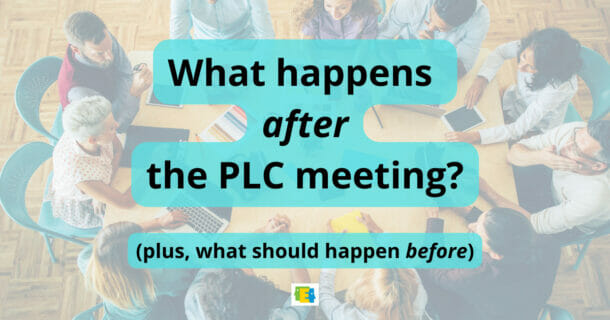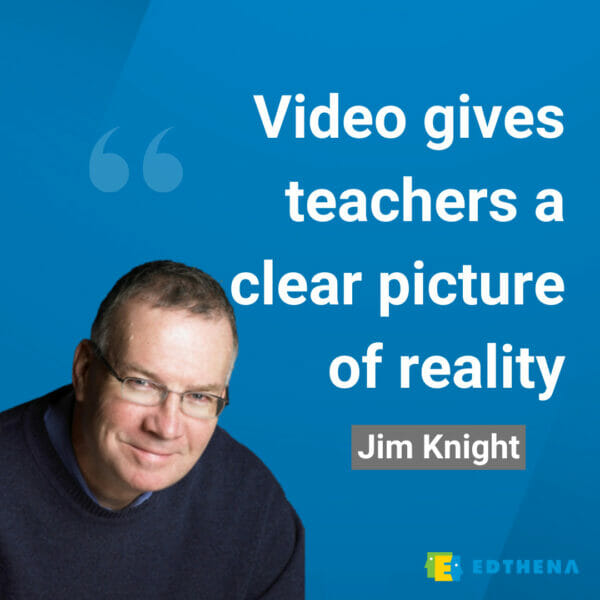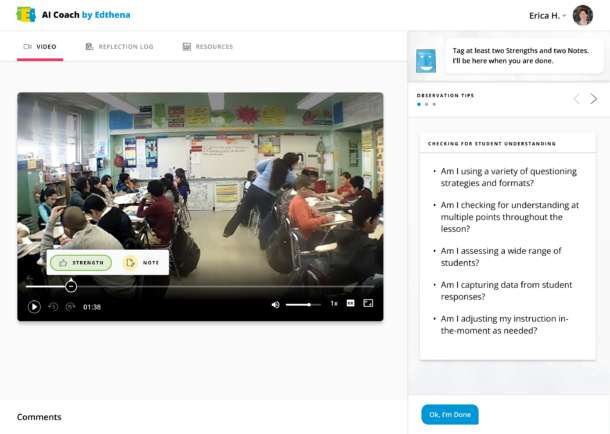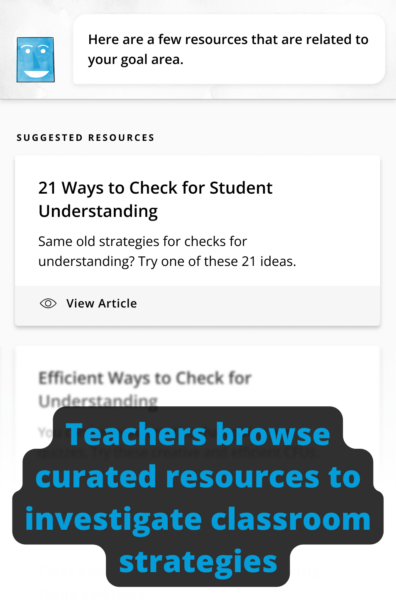2 Protocols to Drive Effective Schoolwide Teacher Collaboration

If you’re supporting teacher collaboration, you won’t achieve this by adding more PLC blocks or team meetings to teachers’ schedules.
This extra time is often unstructured and unproductive for educators.
School leaders and administrators can enable more productive collaboration time by having teachers reflect before and after collaborating with colleagues.
In this post, we’re sharing protocols teachers can use to guide their pre- and post-collaboration reflection.
Keep reading for two reflection protocols, as well as the key things for admins to remember for the structure and support teachers will need.
Strong teacher self-reflection takes support from school leaders
Teacher reflection that truly drives more effective schoolwide collaboration and individual teacher practice doesn’t happen just by telling teachers to “reflect” or emailing them a pre-meeting worksheet to fill out.
As with anything you have teachers do, including following a reflection protocol, you’ll need to provide the supports and structures to enable the critical and complex thinking work required for examining teaching.
In addition to the pre- and post-collaboration reflection protocols like the ones below, remember to think intentionally about systems you’ll put into place to help teachers follow these protocols successfully.
This time and attention from you provide accountability for teachers to understand the value and importance of this extra reflection time on their part.
Pre-Collaboration Protocol: Analyze classroom video before PLC teacher collaboration time
In order for teachers to share best practices and problem-solve when collaborating such as during a PLC, they first must understand what is or is not working effectively in their own classrooms.
One protocol to drive more rich schoolwide discussion is to have teachers independently watch and reflect on videos of their classroom instruction prior to a PLC meeting.
As Jim Knight says, watching their own teaching on video gives teachers access to “a clear picture of their current reality.” This can be more effective than just examining student work or student data.
Pre-Collaboration Reflection Step 1
Begin by asking a PLC group of teachers to identify a shared instructional goal or a specific individual skill to focus on.
For example, maybe the aim for upcoming collaborative PLC time is to consider how to increase use of academic language during student discussions.
Pre-Collaboration Reflection Step 2
Then, you should ask teachers to record a 5-7 minute segment of a lesson that aligns with that identified focus and reflect on their teaching video to look for evidence of academic language from students.
Pre-Collaboration Reflection Step 3
After recording a video, ask teachers to annotate specific moments in their classroom video aligned to the pre-picked goal or skill as they ask themselves:
- What am I noticing about how I am doing X?
- Where do I see that X is effective and how do I know?
- Where do I see that X needs improvement and how do I know?
School administrators should consider how teachers will know what to look for in student or teacher actions that is aligned to their goal.
Coaches, principals, or PLC leaders should also define which artifact representing their pre-collaboration reflection teachers will take to the next PLC meeting to be grounded in data.
Having this reflection ready for teacher collaboration time will be a powerful way for teachers to ensure that the in-person PLC time can quickly move beyond the surface details of what happened and into the thornier topics of what might need to be changed within the classroom space in order to impact student learning.
Post-Collaboration Protocol: Plan how to measure classroom next steps after PD time
Teacher collaboration during shared professional development time often involves brainstorming ideas of instructional improvements or classroom strategies for teachers to try.
School leaders can ensure teachers make the most of these collaboratively generated ideas with a post-PD reflection protocol that helps them understand their instructional impact.
Post-Collaboration Reflection Step 1
After a PD session or workshop, ask teachers to take time to review all of the classroom ideas or strategies generated and pick just one to try.
If they’re not sure how to put an idea into action, consider how you will provide high-quality resources or steps for implementing it in a classroom.
Post-Collaboration Reflection Step 2
In order for teachers to truly know the impact of the strategy or teaching change they try, have them reflect and consider:
- What data will I gather to measure the effectiveness of this strategy for student learning?
- When will I analyze the classroom data I gathered?
- How will I know if this strategy is effective for student learning?
Teachers can do this post-collaboration reflection independently or discuss it with an instructional coach during a coaching conversation.
Those supporting teachers in measuring the impact of the idea they try should offer a system for teachers to document what they decide to do and capture the impact of that change.
Post-Collaboration Reflection Step 3
After teachers implement the next step in their instruction, they should analyze their gathered data per their follow-up timeframe to determine if the teaching change effectively impacted student outcomes and if they will continue it in the classroom.
Following this structured protocol after PD time can help turn the numerous ideas generated through teacher collaboration into concrete next steps with measurable effects on student learning.
More importantly, teachers are empowered to continue doing what works for student learning… and stop doing what doesn’t.
How tech can help you provide teachers with structures to prepare for effective collaboration
Designing and implementing a system that supports teachers to successfully implement reflection protocols and then tracking the follow-through takes an investment of time and energy from the admins in a building.

If you’re a school administrator who wants to enable this type of structured reflection but are short on time, technology tools can help you streamline the process and ensure that teachers feel they have the appropriate supports in place to be successful.
AI Coach by Edthena is a platform designed to support independent reflection for teachers on their classroom videos.
Teachers follow a built-in protocol for the structured reflection process that can come before and after teacher collaboration time. Teachers can complete the AI Coach process before and after their team collaboration times.
First, teachers are asked to focus their reflection on specific instructional skills. This helps them create alignment with their team priorities.
Throughout the reflection process, teachers access personalized reflection questions to guide their independent learning about their classrooms. This means instructional coaches and PD leaders don’t need to create dozens of reflection guides for multiple areas of instructional focus.
After teachers reflect on their teaching videos, teachers develop a plan for how they will implement and monitor progress on classroom next steps.

The AI Coach platform provides a guided process for teachers to:
- define a particular classroom strategy to try
- develop an action plan, including dates for next steps and classroom data to gather
- document the impact of their change on student learning and outcomes, and
- determine if they will continue the change or try another strategy
This provides teachers the structure to determine if a particular strategy impacts student outcomes in their classroom, which is aligned to the best practices of improvement science.
One extra benefit: for educators who may not know how to get started with a new instructional strategy, the AI Coach platform provides curated classroom resources that point teachers in a reliable direction.
For busy school admin and PLC or PD leaders, AI Coach handles all the reminders to teachers about classroom data collection, as well as a safe place to record and synthesize findings in order to successfully complete the reflection process.
Make the most of team collaboration time with structured teacher reflection
Effective teacher collaboration goes beyond the actual team meetings and requires structured reflection both before and after these collaborative times.
Using pre- and post-collaboration reflection protocols empowers educators to better understand their instructional practices and implement actionable next steps.
Tech tools like AI Coach by Edthena can support this reflection process, providing teachers with the necessary structure and resources for successful preparation before and follow-through after teacher collaboration.
Teacher reflection offers an evidence-based way to make the most of educator teamwork and ultimately affect student learning outcomes.
Learn more about AI Coach by Edthena to support your teachers’ reflection and collaborative work.

